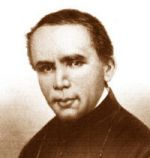Catholic Activity: St. Lucy and the Christmas Wheat
A beautiful Hungarian custom on the feast of St. Lucy (or Lucia) is to plant the "Christmas wheat."
DIRECTIONS
The feast of St. Lucy, December 13, is a favorite among many peoples, especially the Italian and Swedish. St. Lucy''s story is another of the hair-raising tales of martyrdom ending in heavenly triumph and we make the telling of it the focal point of our feast. We have Americanized somewhat the Swedish custom of the Lucy Bride, although we have never been able to work it so that the father and mother of this family were served the traditional coffee and sweet rolls in bed that morning. It is agreed, however, that it is a magnificent idea to be saved for the day when there will be fewer small fry to get up and out to the school bus on St. Lucy''s day.
Monica is always our St. Lucy, one of the rewards for being the only girl in the house. For her crown we omit the lighted candles (a trifle dangerous) but have the boys gather fresh princess pine from the woods. This is made into a wreath bound with two colors of ribbons with streamers to hang down her back. It is after she carries in a Swedish coffee ring crowned with a garland of lighted candles for dessert that she tells her story.
She begins by reminding the family that Lucy comes from the Latin word lux which means light; and since we are preparing for the coming of the Light of the World it is appropriate that her feast falls in Advent. She also reminds us that St. Gregory the Great placed St. Lucy, together with her patroness St. Agatha, in the Canon of the Mass, and there we ask God to grant us "some part and fellowship" with her.
St. Lucy was born in Sicily. Since her mother was ill four years with a hemorrhage, Lucy reminded her that a woman in the Gospels with the same complaint was cured by Our Lord, and suggested that perhaps praying at the tomb of St. Agatha, who died for love of Him, would procure her mother's recovery. They went to the tomb and prayed all night until they fell asleep. St. Agatha appeared to Lucy in a vision, called her "sister" and foretold her martyrdom. Her mother was instantly cured, and as a thanksgiving she gave away most of her money and goods to the poor. She then permitted Lucy to give away all her money and goods to the poor, as well as take a vow of virginity. (Once at a retelling of this story one of our boys observed that probably her mother didn't give away all her goods and money, because someone had to support Lucy.)
Refusing to marry her suitor because she had given herself to Christ, she was denounced by him as a Christian, tried in the praetorium and convicted, then sentenced to be despoiled in a house of ill-fame. (This can be adapted for children by saying she was sentenced to work in slavery with wicked people who were not pure of heart.) But when they tried to drag her off, she would not budge. They brought a yoke of oxen to drag her, but even they could not make her budge. Raging, her persecutors poured pitch, oil, and resin over her and ignited it, only to see her stand amid the flames as cool as a cucumber.
"How is it you do not burn!" they screamed. She replied that it was by the power of her Lord Jesus Christ that she was saved, in order that she might be a witness to Him. With that they plunged a dagger into her throat and she finally died and went straight to Heaven.
A legend that has grown up around St. Lucy has to do with her gouging out her eyes in order to destroy their beauty which had attracted so many admirers. This explains a statue we saw not long ago showing Lucy, sweet faced and crowned, sedately offering us her eyes on a silver platter. Thank you, no, dear St. Lucy — and I don't believe you ever did it in the first place.
She is invoked, however, for assistance with diseases of the eyes, with dysentery and hemorrhages; she is the patron saint of Sicily, especially the city of Syracuse, and apparently the Swedish people fell in love with her when her plucky story was carried north by the early Christian missionaries, and she became their patron saint of schoolgirls. Among the invocations to include in night prayers on her feast is: "Please, dear St. Lucy, help us to love purity."
A beautiful Hungarian custom on the feast of St. Lucy is to plant the "Christmas wheat." Pressed gently into a pot of garden soil, watered, and kept in a moderately warm room, the wheat will be sprouted soft green by Christmas. Then the children may carry it to the creche as a gift for the Child Jesus, symbolic of the Eucharistic bread by which He feeds our souls at the altar as well as of the staff of life by which His Father keeps life in our bodies. For families living in country where wheat is grown, saving a handful of seed for this custom might be an annual event.
Activity Source: Year and Our Children, The by Mary Reed Newland, P.J. Kenedy & Sons, New York, 1956






